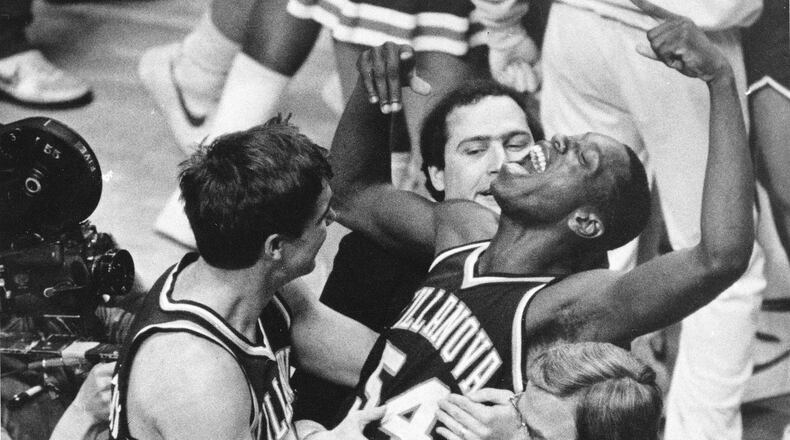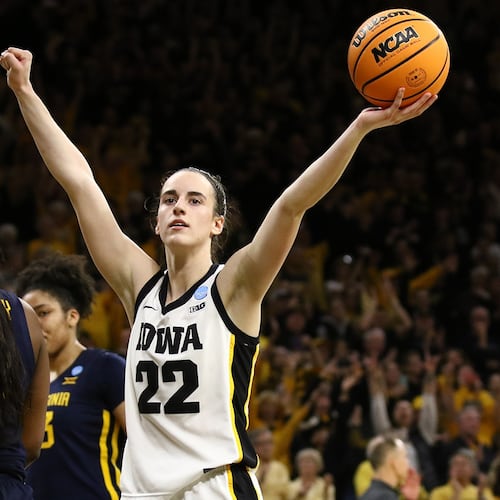There won’t be a Final Four this year — Atlanta’s loss after the NCAA Tournament was canceled due to the coronavirus pandemic. However, The Atlanta Journal-Constitution’s Mark Bradley, a 2015 inductee of the U.S. Basketball Writers Association Hall of Fame, will present his list of the Top 10 Final Fours of all-time. The list will be presented in reverse order, culminating with the greatest men’s basketball championship.
Today: No. 6 — 1985
Bear with me. This is about basketball, I swear. But first …
Secretariat set the Kentucky Derby record in 1973 by winning in 1:59 and 2/5 seconds, a mark that endures. Sham finished second, 2-1/2 lengths behind. The only official times at racetracks are those of the winner’s, but some folks using stopwatches had Sham clocked at 1:59 4/5, which would have been — and would still be — the second-fastest Derby ever run.
Eleven years, 10 months and 25 days after Sham ran second in Louisville, another gallant runner-up walked off the floor in Lexington’s Rupp Arena, which sits 68 miles east of Churchill Downs. They were the Georgetown Hoyas, who’d managed the unthinkable. Playing for a second consecutive NCAA title, they’d outscored their opponent by seven baskets; outrebounded it (though rebounds were few) by three; made four more assists and six fewer turnovers. They sank 54.7% of their shots. And they lost.
Victorious Villanova made 78.6% of its shots, a number that still astounds. The Wildcats’ one second-half miss was blocked by Patrick Ewing. Every Nova shot that reached the rim after halftime went through the hoop.
Georgetown was coming off an authoritative national title. Its defense, which limited a gifted Kentucky team to 3-for-33 shooting in the second half of a Final Four semifinal in 1984, cowed all comers. Opponents made 39.4% of their shots, a national low. The Hoyas’ only losses came against No. 2 St. John’s and No. 11 Syracuse by a total of three points in the span of three days. When matched against those two in the regular season’s final week, Georgetown won by 16 and 27.
The Hoyas beat both again in the Big East tournament. They arrived at the Final Four off a nervous win over Georgia Tech in the East Regional final, and there to meet them was ... St. John's yet again. Georgetown won 77-58. “It just so happens that we came along at the same time they did,” said Bill Wennington of St. John’s. “We’re a good team. We can play with the best teams. Unfortunately, we just did.”
Said St. John’s coach Lou Carnesecca: “When a club like that executes at that level, there’s little you can do.”
Villanova, yet another Big East representative, was a No. 8 seed that reached the Final Four lugging 10 losses, the first coming in The Omni against Georgia in the Cotton States Classic. The Wildcats won the Southeast Regional by upsetting No. 1 seed Michigan and No. 2 North Carolina. They beat Memphis State 52-45 in a nondescript semifinal. They arrived at Monday night having lost twice to Georgetown, though not by a lot — by two in overtime and by seven. They knew what was coming.
Harold Pressley scored on a follow to give Villanova a 29-28 halftime lead. Twice the Wildcats pulled over by six points. Twice Georgetown overrode it. The Hoyas led by one and had a chance to make it three inside the final four minutes — there was no 3-point shot then; no shot clock, either — but Bill Martin bounced a pass off teammate Horace Broadnax’s foot. Villanova took its sweet time (49 seconds) to find sub guard Harold Jensen on the right wing. His jump shot with 2:36 left put the Wildcats ahead to stay.
“We’d play defense right in their face, and they shoot almost 80 percent,” Broadnax said. “It was frustrating.”
Not that a team had ever made almost 80% of its shots in any final, but you’d figure if one did, it would win going away. Villanova won 66-64. That’s how splendid Georgetown was. It lost by two. On April Fool’s Day.
Said Jensen: “It’s too much to believe. I won’t realize the magnitude of this for 10 years.”
For others among us, it didn’t take nearly that long. Villanova’s performance remains the greatest in any NCAA final. Georgetown’s might well have been the second-best.
THE SERIES
About the Author
The Latest
Featured


